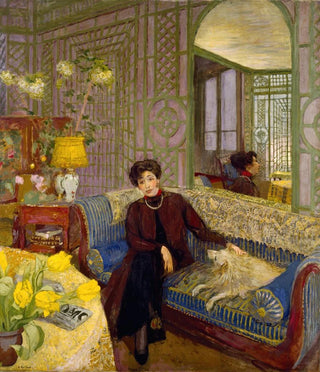Art print | Marcelle Aron Madame Tristan Bernard - Édouard Vuillard


View from behind

Frame (optional)
In the world of art, some works transcend time and space, captivating viewers with their beauty and depth. "Marcelle Aron Madame Tristan Bernard" by Édouard Vuillard is one of those pieces that charms with its intimacy and delicacy. This painting, created at the end of the 19th century, demonstrates Vuillard's mastery in portrait art, while offering a fascinating glimpse into the social and cultural life of his era. Contemplating this piece, the viewer is transported into a universe where every detail, every color, tells a story, revealing the subtleties of human relationships and the complexity of emotions.
Style and uniqueness of the work
Vuillard's style is inimitable, blending influences from Post-Impressionism and Symbolism. In "Marcelle Aron Madame Tristan Bernard," the artist uses soft colors and delicate forms to create an intimate atmosphere. The composition is carefully orchestrated, with particular attention paid to textures and patterns. Marcelle's clothing, as well as the environment surrounding her, are rendered with precision that evokes a sense of warmth and comfort. The play of light and shadow, present in this work, adds an extra dimension, making the portrait lively and dynamic. Vuillard manages to capture not only the appearance of his model but also her essence, her character. This painting is a true ode to femininity, where each brushstroke seems to celebrate the inner and outer beauty of the woman.
The artist and his influence
Édouard Vuillard, a member of the Nabis group, played a major role in the evolution of modern art. His artistic approach is part of a context of research on color, form, and composition. Influenced by masters such as Paul Gauguin and Pierre Bonnard, Vuillard developed a unique style that combines an intimate sensitivity with a decorative approach. His work had a significant impact on many 20th-century artists, who saw in him a source of inspiration to explore new artistic paths. The depiction of interiors and scenes of daily life, as illustrated in "Marcelle Aron Madame Tristan Bernard," opened the

Matte finish

View from behind

Frame (optional)
In the world of art, some works transcend time and space, captivating viewers with their beauty and depth. "Marcelle Aron Madame Tristan Bernard" by Édouard Vuillard is one of those pieces that charms with its intimacy and delicacy. This painting, created at the end of the 19th century, demonstrates Vuillard's mastery in portrait art, while offering a fascinating glimpse into the social and cultural life of his era. Contemplating this piece, the viewer is transported into a universe where every detail, every color, tells a story, revealing the subtleties of human relationships and the complexity of emotions.
Style and uniqueness of the work
Vuillard's style is inimitable, blending influences from Post-Impressionism and Symbolism. In "Marcelle Aron Madame Tristan Bernard," the artist uses soft colors and delicate forms to create an intimate atmosphere. The composition is carefully orchestrated, with particular attention paid to textures and patterns. Marcelle's clothing, as well as the environment surrounding her, are rendered with precision that evokes a sense of warmth and comfort. The play of light and shadow, present in this work, adds an extra dimension, making the portrait lively and dynamic. Vuillard manages to capture not only the appearance of his model but also her essence, her character. This painting is a true ode to femininity, where each brushstroke seems to celebrate the inner and outer beauty of the woman.
The artist and his influence
Édouard Vuillard, a member of the Nabis group, played a major role in the evolution of modern art. His artistic approach is part of a context of research on color, form, and composition. Influenced by masters such as Paul Gauguin and Pierre Bonnard, Vuillard developed a unique style that combines an intimate sensitivity with a decorative approach. His work had a significant impact on many 20th-century artists, who saw in him a source of inspiration to explore new artistic paths. The depiction of interiors and scenes of daily life, as illustrated in "Marcelle Aron Madame Tristan Bernard," opened the






